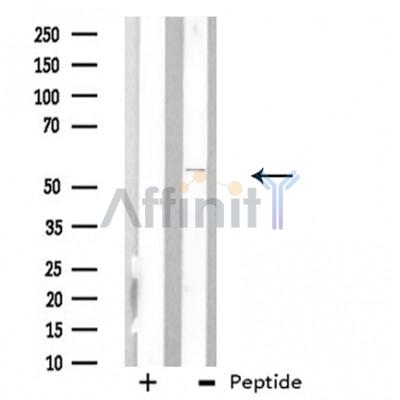ARFGAP3 Antibody - #DF3748
| Product: | ARFGAP3 Antibody |
| Catalog: | DF3748 |
| Description: | Rabbit polyclonal antibody to ARFGAP3 |
| Application: | WB IHC IF/ICC |
| Reactivity: | Human, Mouse |
| Prediction: | Pig, Zebrafish, Bovine, Horse, Sheep, Dog, Chicken, Xenopus |
| Mol.Wt.: | 57kd,66kDa; 57kD(Calculated). |
| Uniprot: | Q9NP61 |
| RRID: | AB_2836112 |
Related Downloads
Protocols
Product Info
*The optimal dilutions should be determined by the end user.
*Tips:
WB: For western blot detection of denatured protein samples. IHC: For immunohistochemical detection of paraffin sections (IHC-p) or frozen sections (IHC-f) of tissue samples. IF/ICC: For immunofluorescence detection of cell samples. ELISA(peptide): For ELISA detection of antigenic peptide.
Cite Format: Affinity Biosciences Cat# DF3748, RRID:AB_2836112.
Fold/Unfold
ADP ribosylation factor GTPase activating protein 1; ADP ribosylation factor GTPase activating protein 3; ADP-ribosylation factor GTPase-activating protein 3; ARF GAP 3; ARFG3_HUMAN; ArfGAP 3; ARFGAP1; ARFGAP3; FLJ45618;
Immunogens
A synthesized peptide derived from human ARFGAP3, corresponding to a region within C-terminal amino acids.
Widely expressed. Highest expression in endocrine glands (pancreas, pituitary gland, salivary gland, and prostate) and testis with a much higher expression in the testis than in the ovary.
- Q9NP61 ARFG3_HUMAN:
- Protein BLAST With
- NCBI/
- ExPASy/
- Uniprot
MGDPSKQDILTIFKRLRSVPTNKVCFDCGAKNPSWASITYGVFLCIDCSGSHRSLGVHLSFIRSTELDSNWSWFQLRCMQVGGNASASSFFHQHGCSTNDTNAKYNSRAAQLYREKIKSLASQATRKHGTDLWLDSCVVPPLSPPPKEEDFFASHVSPEVSDTAWASAIAEPSSLTSRPVETTLENNEGGQEQGPSVEGLNVPTKATLEVSSIIKKKPNQAKKGLGAKKGSLGAQKLANTCFNEIEKQAQAADKMKEQEDLAKVVSKEESIVSSLRLAYKDLEIQMKKDEKMNISGKKNVDSDRLGMGFGNCRSVISHSVTSDMQTIEQESPIMAKPRKKYNDDSDDSYFTSSSSYFDEPVELRSSSFSSWDDSSDSYWKKETSKDTETVLKTTGYSDRPTARRKPDYEPVENTDEAQKKFGNVKAISSDMYFGRQSQADYETRARLERLSASSSISSADLFEEPRKQPAGNYSLSSVLPNAPDMAQFKQGVRSVAGKLSVFANGVVTSIQDRYGS
Predictions
Score>80(red) has high confidence and is suggested to be used for WB detection. *The prediction model is mainly based on the alignment of immunogen sequences, the results are for reference only, not as the basis of quality assurance.
High(score>80) Medium(80>score>50) Low(score<50) No confidence
Research Backgrounds
GTPase-activating protein (GAP) for ADP ribosylation factor 1 (ARF1). Hydrolysis of ARF1-bound GTP may lead to dissociation of coatomer from Golgi-derived membranes to allow fusion with target membranes.
Cytoplasm. Golgi apparatus membrane>Peripheral membrane protein>Cytoplasmic side.
Note: Also found on peripheral punctate structures likely to be endoplasmic reticulum-Golgi intermediate compartment.
Widely expressed. Highest expression in endocrine glands (pancreas, pituitary gland, salivary gland, and prostate) and testis with a much higher expression in the testis than in the ovary.
Research Fields
· Cellular Processes > Transport and catabolism > Endocytosis. (View pathway)
Restrictive clause
Affinity Biosciences tests all products strictly. Citations are provided as a resource for additional applications that have not been validated by Affinity Biosciences. Please choose the appropriate format for each application and consult Materials and Methods sections for additional details about the use of any product in these publications.
For Research Use Only.
Not for use in diagnostic or therapeutic procedures. Not for resale. Not for distribution without written consent. Affinity Biosciences will not be held responsible for patent infringement or other violations that may occur with the use of our products. Affinity Biosciences, Affinity Biosciences Logo and all other trademarks are the property of Affinity Biosciences LTD.





